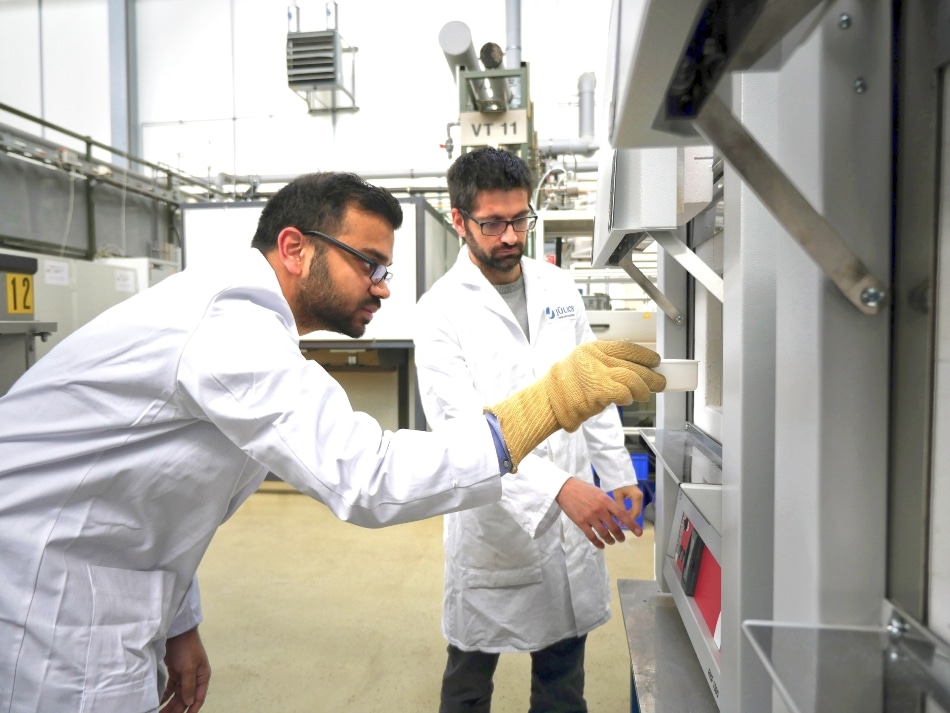Apr 4 2019
MAX phases are seen as favorable materials for the future, for instance, for turbines in power plants and aircraft, medical implants or space applications. A new technique formulated by researchers from Forschungszentrum Jülich presently makes it possible to create this promising material family on a mass scale for the first time: a crust of salt safeguards the raw material from oxidation at a fabrication temperature of over 1,000 °C – and can then merely be washed off with water. The technique, which was recently reported in the journal Nature Materials, can also be applied to other high-performance materials.
 Dr. Jesus Gonzalez-Julian (right) and Apurv Dash (left) (Copyright: Forschungszentrum Jülich / Regine Panknin)
Dr. Jesus Gonzalez-Julian (right) and Apurv Dash (left) (Copyright: Forschungszentrum Jülich / Regine Panknin)
MAX phases combine the positive properties of both metals and ceramics. They are heat resistant and lightweight like ceramics, yet less delicate, and can be plastically deformed like metals. Additionally, they are the material basis of MXenes, a largely unfamiliar group of compound that are like the “miracle material” graphene and have astonishing electronic properties.
“In the past, there was no suitable method for producing MAX phases in powder form, which would be advantageous for further industrial processing. This is why MAX phases have not played any practical role in industrial application so far,” explains Junior Professor Dr. Jesus Gonzalez-Julian, young investigators group leader at Forschungszentrum Jülich.
The salt strategy
MAX phases are formed at temperatures of more than 1,000 °C. At such high temperatures, the materials would usually react with atmospheric oxygen and oxidize, which is why they are typically manufactured in a protective atmosphere of argon or in a vacuum. The Jülich technique is surprisingly basic by comparison: the raw material is encapsulated by the scientists with a salt – potassium bromide – which melts during the manufacture process. A vacuum or argon atmosphere for extra protection is not needed anymore.
“A bath of molten salt thus protects the material and prevents it from coming in contact with atmospheric oxygen,” explains Apurv Dash, lead author of the study published in Nature Materials and doctoral researcher at Forschungszentrum Jülich.
Simultaneously, the salt serves as a separating agent: the components do not bond together anymore to form a compact solid, and enable the direct manufacture of fine-grained powders. This is crucial because it avoids an extra-long, energy-demanding milling process. As a positive side effect, the salt bath also decreases the synthesis temperature needed to form the preferred compound, which will further reduce energy and production costs.
With just salt and water
For some time, techniques using molten salt have been used for the powder manufacture of non-oxide ceramics. However, they need a protective argon atmosphere rather than atmospheric air, which increases the complexity as well as the production costs.
Potassium bromide, the salt we use, is special because when pressurized, it becomes completely impermeable at room temperature. We have now demonstrated that it is sufficient to encapsulate the raw materials tightly enough in a salt pellet to prevent contact with oxygen – even before the melting point of the salt is reached at 735 degrees Celsius. A protective atmosphere is thus no longer necessary.
Apurv Dash, Study Lead Author and Doctoral Researcher, Forschungszentrum Jülich.
As with a number of scientific discoveries, a little bit of providence had a role to play in inventing the technique: vacuum furnaces are uncommon because they are extremely expensive and require a lot of effort to clean. To make his powder, the Jülich doctoral researcher, thus, chose to test a normal air furnace – positively!
The new technique is not restricted to a specific material. The scientists have already created a horde of different MAX phases and other high-performance materials, such as titanium alloys for aircraft engineering and bio-implants. As a follow up step, the researchers are currently planning to explore industrial processes with which these powders can be additionally processed.
Falling Walls Lab 2018 - Apurv Dash - Breaking the Wall of Oxidation by Salting
Falling Walls Lab 2018 - Apurv Dash - Breaking the Wall of Oxidation by Salting